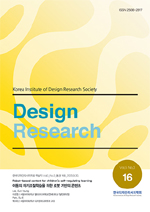
초등학교 5·6학년 미술 교과의 온라인 학습을 위한 이모티콘 디자인 교육콘텐츠 개발
Development of emoticon design education content for online learning of art subjects by 5th and 6th graders in elementary schools
- 한국디자인리서치학회
- 한국디자인리서치
- Vol8, No. 4(통권 29권)
- 2023.12
- 553 - 563 (11 pages)
정보통신의 발전, COVID-19와 같은 질병의 확산으로 인한 비대면 소통이 활발히 이루어지면서, 비언어적 표현을 전달하는 이모티콘은 사회 및 경제적 측면에서 그 중요성이 인식되고 있다. 따라서 학교 미술 교육에서도 이모티콘 관련 교육이 다수 이루어지고 있다. 하지만 현재 이루어지고 있는 이모티콘 교육 관련 내용은 이모티콘에 대한 간략한 정의와 예시만 제시될 뿐, 그 내용 면에서 심도 있는 디자인교육으로서의 부족함이 발견되었다. 특히 COVID-19 이후 대부분의 학교가 온라인 수업을 병행되면서 실기·체험 중심의 미술 교과는 그 실행방법에 대한 전환의 요구되는 상황이다. 따라서 본 연구에서는 온라인 수업에서 적용이 용이하면서 시의성이 높은 주제인 이모티콘 디자인을 주제로 선정하여, 2015 개정 교육과정 성취기준을 바탕의 초등학교 5·6학년 미술 교과 온라인 교육콘텐츠를 제안하였다. 주요 개발 내용 요소는 ‘이모티콘의 필요성, 어원 및 개념, 재료, 디자인 제작 방법, 참고 자료, 활용 예시’ 등으로, 이는 선행연구에서 부족함이 발견된 부분을 보완한 것이다. 개발된 내용은 현장 교사 3인에게 ‘난이도, 적용 적합성, 내용 구성의 타당도’ 영역에서 검토되었다. 그 결과, 세 영역 모두에서 적합하다는 결과가 도출되었다.
As remote communication becomes more active due to the advancement of information and communications technology and the spread of diseases such as COVID-19, the importance of emoticons that convey non-verbal expressions is recognized in social and economic terms. Thus, although emoticon-related education is being provided in school art education, only brief definitions and examples are provided for emoticon-related content, and in-depth design education activities are lacking in terms of content. Above all, after COVID-19, as most classes at schools are conducted in parallel with online classes, art subjects focusing on practical and experiential learning are in need of a change in their implementation methods. Therefore, in this study, emoticon design, a topic that is easy to apply and has the value of timeliness in online classes, was selected as the topic and developed based on the 2015 revised curriculum achievement standards. The main development content elements make up for the shortcomings found in previous research, such as ‘necessity of emoticons, origin of emoticons and concept, materials, design production method, reference materials, and examples of use.’ The developed content was reviewed by three elementary and middle school teachers in the areas of ‘difficulty, suitability for application, and validity of content structure’, and the results were found to be appropriate in all three areas.
1. 서론
2. 이론적 배경
3. 이모티콘 디자인 온라인 학습 콘텐츠 개발
4. 이모티콘 디자인 온라인 학습 콘텐츠 평가
5. 결론 및 제언
참고문헌